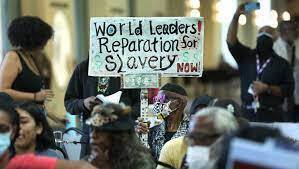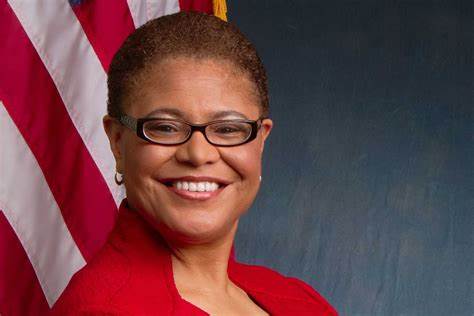
California Reparations Task Force
(BBR) The California Reparations Task Force will vote on a series of proposals this weekend that could see descendants of slavery living in the state each receive up to $1.2 million.
In a series of documents published Monday, the task force indicated it will vote Saturday to recommend the state of California officially apologize for racism and slavery and offer “down payments” of varying amounts to eligible Black residents.
Here’s what to know about the proposals, which could cost more than $800 billion if they became law.
What is the task force?
In October 2020, Gov. Gavin Newsom (D) signed Bill AB 3121 into law — creating the nation’s first ever task force to study and recommend reparations for slavery.
At the time, the country was still grappling with the murder of George Floyd, who had been killed by a Minneapolis police officer in May of that year. Newsom said the “painful history of slavery has evolved into structural racism and bias built into and permeating throughout our democratic and economic institutions.”
Today, the task force is headed by nine members — five appointed by the governor, two appointed by the president pro tempore of the state Senate, and two members by the state Speaker of the Assembly. A majority of the task force members are Black.
Last year, the task force released a 500-page report detailing the impact of slavery and systemic discrimination across the nation and in the state.
In addition to addressing racial disparities by police officers and in incarceration, the report called for “a detailed program of reparations for African Americans” and for the federal government to create a reparations commission.
It highlighted how programs like Social Security and the GI Bill often excluded Black Americans and created a wealth gap that has persisted since before the passage of the 1964 Civil Rights Act.
“160 years after the abolition of slavery, its badges and incidents remain embedded in the political, legal, health, financial, educational, cultural, environmental, social, and economic systems of the United States of America,” the task force said.
“Without a remedy specifically targeted to dismantle our country’s racist foundations and heal the injuries inflicted by colonial and American governments, the ‘badges and incidents of slavery’ will continue to harm African Americans in almost all aspects of American life,” it added.
Who qualifies for reparations?
The task force announced in a March 2022 report that any descendant of enslaved African Americans or of a “free Black person living in the United States prior to the end of the 19th century” would be eligible for reparations.
More than 2.5 million, or about 6.5 percent, of Californians are Black, according to the latest data from the U.S. Census Bureau, though that doesn’t mean all can trace their heritage back to meet these requirements.
The task force does state that in order to be eligible for reparations, applicants must be a resident of California — and have proof — that they have been a resident for at least six months of time within each area of harm.
Eligible residents should be compensated for each area of harm, the report added, regardless of direct or indirect harm.
“The State of California created laws and policies discriminating against and subjugating free and enslaved African Americans and their descendants,” the task force said. “In doing so, these discriminatory policies made no distinctions between these individuals; the compensatory remedy must do the same.”
How much in reparations is being recommended?
The proposal lists three specific areas for reparations: mass incarceration and over policing; discrimination in housing, such as redlining that left Black families unable to receive home loans; and harms to health, including unequal access to health care and environmental injustices.
The task force also looked into how much to award based on a number of factors, including length of the harm and length of the person’s residency, as well as whether the person was directly harmed and how the payment would correspond to damages.
For restitution for mass incarceration and over policing in Black communities, the proposal suggests providing $115,260 per person in 2020 dollars — or $2,352 for each year of residency in the state since 1971, which was the first year of the war on drugs.
During the war on drugs, Black Americans convicted of crack offenses were sentenced to nearly double the amount of time as white people convicted of the same offense, according to the National Association of Criminal Defense Lawyers.
Today, Black men make up about 13 percent of the nation’s population but about 35 percent of those incarcerated. Similarly, Black women make up about 13 percent of the female population but 44 percent of incarcerated women.
For those who faced discriminatory housing policies between 1933 and 1977, when redlining mostly occurred, the proposal suggested $148,099 per person, or $3,366 for each year.
Black families own just one-tenth the wealth of white families, and housing discrimination has played a major component in the wealth gap.
The effects of redlining saw housing costs soar in Black communities at the same time the neighborhoods saw disinvestment. Today, homes in predominantly Black neighborhoods are valued at $48,000 less than predominantly white neighborhoods, according to the Brookings Institution, leading to an equity loss of nearly $156 billion. Black Americans today have a homeownership rate of 46.4 percent compared to 75.8 percent of white families.
For the health care disparities Black Californians have faced — including environmental pollution and discrimination by health care workers — the task force recommended $13,619 per person for every year lived in California.
In California, Black residents have an average lifespan of 71 years following the COVID-19 pandemic, a decrease of four years prior to the pandemic, so a total of $966,921 would be awarded.
But even before the pandemic, health care disparities persisted.
According to the report, the reduction in Black life expectancy is the result of discrimination, including “state-sanctioned medical experimentation and sterilization, segregation of healthcare facilities and the denial of funds to facilities or doctors that treated African Americans in California.”
Meanwhile, discriminatory local zoning exposed many Black neighborhoods to toxic industries and generated food deserts, or areas with limited access to nutritious food.
When will payouts begin?
Though the task force is set to meet Saturday to vote, their vote is simply a recommendation; the state legislature and governor will have the final say on whether to follow the task force’s suggestions.
And any bill that heads to Newsom’s desk is likely to face pushback from Republicans and moderate Democrats, who are against cash payments.
In 2020, 12 lawmakers voted against the task force creation, according to CalMatters. In a recent informal poll emailed to the 80 Assemblymembers conducted by CalMatters, only three legislators expressed support for the task force’s effort. The rest did not respond.
Christie slams Trump’s ‘ridiculous’ response to E. Jean Carroll verdict
Biden rules limit asylum as White House grapples with end of Title 42
Moreover, the questions of whether the state even has the finances for the payouts has been brought into question. California has an annual budget of around $237 billion, but economists on the panel said reparations could cost the state more than $800 billion.
And the panel added that the list of suggested sums is not exhaustive — these numbers lean on the conservative side and at best are a “very cautious initial assessment for what cost, at a minimum, the State of California is responsible.”
Still, the panel recommends instead of paying out a lump sum to eligible residents, the state begins with a “down payment” of a “meaningful amount of funds” as the first step toward reparations.




















